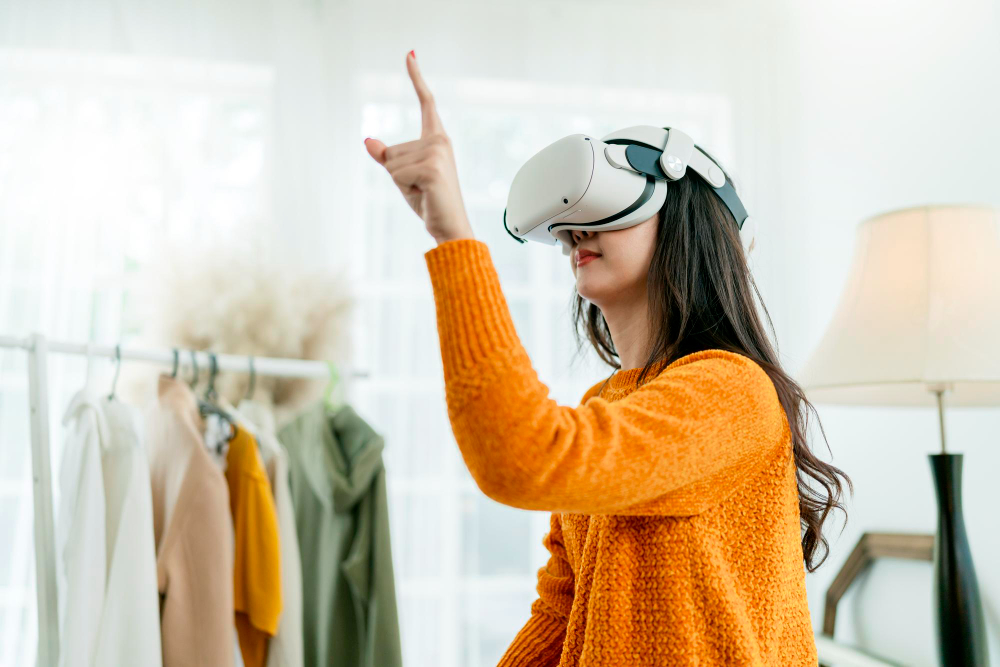In recent years, the retail landscape has undergone a significant transformation with the integration of augmented reality (AR) technology. Augmented reality, once confined to the realms of science fiction, has now become a powerful tool reshaping how consumers interact with brands and products. From enhancing customer engagement to revolutionizing the shopping journey, AR is paving the way for a more immersive and personalized retail experience.
- The benefits of using augmented reality in retail
How augmented reality is enhancing the in-store shopping experience - Augmented reality in online retail: virtual try-on and product visualization
- Augmented reality in marketing and advertising for retail
- Examples of successful augmented reality
- implementations in retail
- The future of augmented reality in retail shopping
- Challenges and considerations when implementing augmented reality in retail
- Augmented reality tools and platforms for retail businesses
Table of Contents
Augmented Reality is Transforming the Retail Shopping Experience.
Augmented reality refers to the technology that superimposes digital elements onto the real world, thereby enhancing the user’s perception and interaction with their environment. Unlike virtual reality, which creates a completely immersive experience, AR overlays digital content onto the physical world, blending the virtual with the real.
Although augmented reality offers many benefits to retailers, there are also challenges and considerations that retailers must take into account when adopting this technology. One of the biggest challenges is the cost of implementation. Developing and implementing AR solutions can be expensive, especially for small retailers with limited resources. However, as the technology becomes more widespread and accessible, costs are expected to fall, making it easier for retailers of all sizes to adopt augmented reality.
The Growing Importance of AR in Retail
In an increasingly competitive retail landscape, brands are constantly seeking innovative ways to capture the attention of consumers and differentiate themselves from competitors. Augmented reality has emerged as a game-changer in this regard, offering retailers a unique opportunity to elevate the shopping experience and drive customer engagement.
For example, augmented reality could be integrated into smart mirrors, allowing customers to virtually try on clothes and adjust their outfits with just a few taps. We may also see the development of AR-enabled shopping assistants that guide customers through the store and provide personalized recommendations and product information.
Enhancing Customer Engagement with AR
One of the key ways in which AR is transforming the retail shopping experience is by enhancing customer engagement. AR enables shoppers to interact with products in ways that were previously impossible, thereby providing them with a more immersive and interactive shopping experience.
- AR Product Visualization: By leveraging AR technology, retailers can allow customers to visualize products in their real-world environment before making a purchase. Whether it’s trying out furniture in their living room or seeing how a pair of shoes looks on their feet, AR product visualization enables customers to make more informed purchasing decisions.
- Virtual Try-Ons: Another area where AR is making waves in the retail industry is virtual try-ons. With AR-powered fitting rooms, customers can try on clothing and accessories virtually, eliminating the need for physical fitting rooms and reducing the hassle associated with trying on multiple items.
Personalized Shopping Experience Through AR
In addition to enhancing engagement, AR is also enabling retailers to deliver a more personalized shopping experience to their customers.
- Customization and Configuration: AR technology allows customers to customize and configure products according to their preferences, whether it’s selecting different colors, patterns, or styles. This level of customization not only enhances the shopping experience but also fosters a deeper connection between the customer and the brand.
- Product Recommendations: By analyzing customer data and preferences, retailers can use AR to deliver personalized product recommendations to shoppers. Whether it’s suggesting complementary products or showcasing items that align with their tastes, AR-powered recommendations help retailers increase sales and drive customer loyalty.
Overcoming Physical Limitations with AR
Another advantage of AR in the retail sector is its ability to overcome physical limitations and barriers that customers may encounter during the shopping process.
- Size and Fit Assessment: One of the biggest challenges of online shopping is accurately assessing the size and fit of clothing and accessories. AR technology addresses this issue by enabling customers to virtually try on items and see how they fit in real-time, reducing the likelihood of returns and exchanges.
- Visualizing In-Store Layouts: For brick-and-mortar retailers, AR can enhance the in-store shopping experience by providing customers with digital overlays of store layouts and product information. This not only helps shoppers navigate the store more efficiently but also provides them with additional product details and recommendations.
Implementing AR in Retail Operations
To fully harness the power of AR in retail, it’s essential for brands to integrate this technology seamlessly into their operations.
- Integration with Mobile Apps: Many retailers are incorporating AR features into their mobile apps, allowing customers to access AR-powered experiences directly from their smartphones. Whether it’s scanning products in-store or trying on virtual makeup, mobile AR apps provide a convenient and accessible way for customers to engage with brands.
- In-Store AR Displays: In addition to mobile apps, some retailers are also implementing AR displays in-store to showcase products and provide interactive experiences for shoppers. From virtual fitting rooms to interactive product demonstrations, in-store AR displays create memorable experiences that drive foot traffic and increase sales.
Case Studies: Successful Implementation of AR in Retail
Several brands have already embraced AR technology and successfully integrated it into their retail operations. Case studies of companies that have leveraged AR to enhance the shopping experience and drive business results can provide valuable insights and inspiration for other retailers looking to adopt this technology.
Augmented reality offers many benefits to both retailers and consumers. For retailers, it provides an opportunity to stand out in a crowded marketplace and create a unique and memorable shopping experience. By integrating augmented reality into their stores and their websites, retailers can attract and engage customers in innovative ways. This technology allows retailers to present products in a more interactive and immersive way, making it easier for customers to visualize and understand product features and benefits that interest them. Additionally, augmented reality can help retailers reduce returns and improve customer satisfaction, allowing shoppers to virtually try on clothes and test products before making a purchase.
Future Trends and Innovations in AR Retail
As technology continues to evolve, the future of AR in retail looks promising. From advances in wearable AR devices to the integration of artificial intelligence and machine learning, the possibilities for innovation are endless. Retailers that stay ahead of the curve and embrace these emerging trends will be well-positioned to thrive in the digital age.
Augmented reality is blurring the boundaries between the physical and digital worlds and revolutionizing the in-store shopping experience. Retailers are using his AR technology to create interactive displays and installations that captivate and engage customers. For example, some stores are introducing AR mirrors that allow shoppers to virtually try on different outfits without changing clothes. These mirrors use advanced algorithms to map the garment to the customer’s body, creating a realistic and accurate representation of the garment’s appearance. This not only saves time and effort, but also makes the shopping experience more interactive and enjoyable, improving the overall shopping experience.
Challenges and Limitations of AR in Retail
While AR offers many benefits to retailers and consumers alike, it also presents its own set of challenges and limitations. From technical constraints to privacy concerns, retailers must carefully navigate these obstacles to ensure the successful implementation of AR technology in their operations.
In addition to improving the shopping experience, augmented reality is also being used in retail marketing and advertising campaigns. AR allows retailers to create interactive, attention-grabbing ads that capture the imagination of their target audience. For example, some retailers have used AR to create virtual stores and pop-up shops in crowded urban areas. A passerby can use his smartphone or his AR-enabled device to explore and interact with these virtual stores, making the shopping experience more accessible and exciting.
The potential for augmented reality in retail is huge and the future is incredibly bright. As the technology continues to evolve, we expect to see even more innovative and surprising uses of AR in retail.
FAQs on AR retail shopping
- How does augmented reality benefit retailers? Augmented reality benefits retailers by enhancing customer engagement, providing personalized shopping experiences, and overcoming physical limitations associated with traditional retail environments.
- Are there any privacy concerns associated with AR technology in retail? Yes, privacy concerns are a consideration with AR technology, particularly regarding data collection and security. Retailers must implement robust privacy policies and safeguards to protect customer information.
- What are some examples of successful AR implementations in retail? Examples of successful AR implementations in retail include virtual try-on experiences for clothing and accessories, AR-powered product visualization tools, and interactive in-store displays.
- How can retailers overcome technical challenges when implementing AR? Retailers can overcome technical challenges by partnering with experienced AR developers, investing in robust infrastructure and hardware, and conducting thorough testing and optimization processes.
- What are the future trends in AR retail? Future trends in AR retail include advancements in wearable AR devices, the integration of AI and machine learning, and the development of more immersive and interactive AR experiences.
Conclusion
In conclusion, augmented reality is revolutionizing the retail shopping experience by offering immersive, personalized, and engaging experiences for consumers. From AR product visualization to virtual try-ons, retailers are leveraging this technology to enhance customer engagement, drive sales, and differentiate themselves in a competitive market landscape. As AR continues to evolve, it will undoubtedly play a central role in shaping the future of retail.











